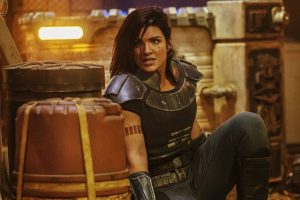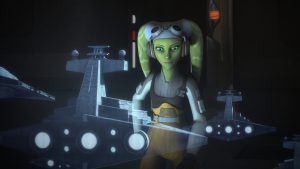SPOILERS FOR THE FALCON AND THE WINTER SOLDIER AHEAD!
If you had told me even as recently as yesterday that the first episode of Marvel’s The Falcon And The Winter Soldier would consist mostly of characters struggling to obtain bank loans or get back into the dating scene, I’d have told you that sounded more like a prompt for a fluffy domestic AU (Alternate Universe) fanfic, and that we’d be lucky to have something like that adapted to the small screen. But that’s…almost exactly what this episode is, from start to finish. It feels like soft, wholesome, fanfiction in the best way possible.

Although there are a few sequences of high-stakes, high-speed action throughout the episode, and it ends on a rather epic cliffhanger that’s got Twitter in an uproar, the forty-minute long pilot episode doesn’t advance the plot much further forward than what was already covered in the The Falcon And The Winter Soldier‘s synopsis, teasing only a little bit of upcoming drama while diving deep into the personal lives of our protagonists, Sam Wilson (Anthony Mackie) and Bucky Barnes (Sebastian Stan), whose plotlines don’t even intersect by the end. But like some of the best fanfics, the narrative is mostly just characters going about their daily lives and interacting with everyday scenarios and problems, but layered over with complex social commentary and the kind of attention to detail that we’ve almost always had to turn to fanfiction for, at least when it comes to the MCU proper (this was never a problem with Agents Of S.H.I.E.L.D., part of the reason why it remains peak Marvel TV).
It’s a bold choice, particularly when most audiences were expecting nonstop action, but it’s a choice that’s already paying off. To name just one example, Bucky, who’s probably had more fanfic written about him than just about any other Marvel character ever, is finally utilizing the relative peace and quiet of the post-Blip MCU to conquer his inner demons and find healing with the help of a military therapist (a small but standout role brilliantly played by Amy Aquino). The refusal of Marvel superheroes to go to therapy has become a long-running joke in the fandom, making this whole subplot look and feel a lot like the intricate canon “fixes” that fanfic writers create every time a Marvel movies leaves them disappointed…particularly when you sprinkle in world-building details; like Bucky’s little list of people with whom he has to make amends, from a HYDRA agent he helped install in Congress to the elderly father of one of his victims; his adorable grin when he helps bring down the aforementioned HYDRA agent without even having to maim or kill anyone; or simply the fact that he sleeps on the floor of his apartment because he’s not used to beds, and still suffers from nightmares about his past.
Therapy and healing is the most natural progression for such a traumatized and battle-torn character, whose only just now getting the chance to actually explore the world again, and is…doing a pretty awful job of it, to be honest. He’s completely alone in the civilian world, and, given how badly he messes up a halfhearted attempt at a date (as the MCU once again tries to push the obviously false narrative that Bucky is straight, the only part of the episode that threatens to shatter the fanfic façade), he’s likely to remain alone for some time.
Meanwhile in Louisiana, the Falcon is taking a break from active duty to be with his extended family, who are already some of the loveliest, most genuine civilian characters in the MCU. The exploration of Sam Wilson’s backstory, across all his movie appearances thus far, has amounted to only a few lines about his military service, so it’s nice to finally learn something about the man behind the titanium wings, and for it to be a Black screenwriter (Malcolm Spellman) who gets to establish these new aspects of the character. Sam spends most of the episode trying to help out his sister Sarah (Adepero Oduye), whose small business is going down along with the rusty old fishing-trawler she inherited from their parents, but they’re approaching the same goal from very different perspectives – Sam, who spent five years as cosmic dust and has only been alive again for about six months, is still optimistic, convinced he can swoop in and save the day like he’s always done. Sarah, who survived the Snap, has no such delusions: she’s barely getting by raising two children on her own, and she can’t afford to entertain Sam’s overconfidence.

Their attempt to take out a bank loan is one of the strongest sequences in the episode: a fascinating look at how inadequately prepared superheroes are to return to civilian life, and a microcosm of how MCU society views its heroes in general, as symbols and props to be worshipped, names and logos to be slapped on merchandise, faces to be captured in selfies…but no humanity. There’s something deeply exploitative about it all, and it’s what inspires the Wilsons’ banker to think he can simultaneously reject their request for a loan while pleading with Falcon for a photo of him with his arms out, doing the wing-motions.
That it’s a white man getting away with this behavior makes it clear what Spellman’s script is trying to say about the exploitation of Black lives in every aspect of society, particularly in media and politics. How many times have Black women voters in a state like Georgia been called upon, even expected, to “save” America from our nation’s never-ending cycle of moral failings, only for white elected officials to, at best, ignore their needs completely? On my first viewing of this episode, I missed the point of the banker’s question to Sam, about who paid him to work as a superhero, and Sam’s loaded response that no one ever did.
It’s particularly interesting to see how that same concept plays into Sam’s decision earlier in the episode to give up Captain America’s legendary shield, handing it over to the Smithsonian so the symbol can officially be retired and a new one take its place…only for the US Government to promptly ignore that decision and hand-pick a “new Captain America”, a square-jawed patriotic puppet named John Walker (Wyatt Russell), who exists to be exploited as propaganda, to stamp his seal of approval on all the nation’s most controversial decisions, from war-crimes to nuclear weaponry. He is a tool of his government, without free will or an identity of his own, and he represents everything that Falcon was fighting against in Captain America: Civil War.
The core conflict of The Falcon And The Winter Soldier seems to be this one of the exploitation and commodification of superheroes, which makes the series’ apparent antagonists all the more intriguing – the terrorist group known as the Flag-Smashers are certainly violent, but their agenda to unite the world in anarchy with neither heroes nor symbols opens an opportunity for more commentary on similar topics, such as the dangers of celebrity worship. As of yet, we still don’t know how Bucky’s arch-nemesis Baron Zemo will play into things, though his name appears on the Winter Soldier’s list – and I can’t imagine Bucky will have a cute grin in store for the man who brainwashed him into attacking his best friend.

If you’re just here for the action sequences, I’m afraid this pilot might be a bit of a letdown. Bucky doesn’t get to do much fighting at all, while Falcon’s mid-air hostage rescue in Tunisia is definitely a lot of fun (and marks the return of Winter Soldier villain Georges Batroc, a role reprised by Georges St-Pierre) but drags a little. What I’m looking for from Falcon’s action sequences is unique usage of his signature wings, and I think there’s still work to be done in that area.
But if you’ve managed to move on from feelings of post-WandaVision depression and are ready for a new series, then The Falcon And The Winter Soldier offers something that feels familiar and enjoyable, but hides just as many dark and mature themes below its surface as WandaVision. The difference is that, whereas WandaVision was about torturing Wanda to the brink of despair, The Falcon And The Winter Soldier is soft and fluffy, and features unforgettable moments like Bucky shaking hands with a Maneki-neko “waving cat” statue. Good stuff.
Episode Rating: 8.5/10








